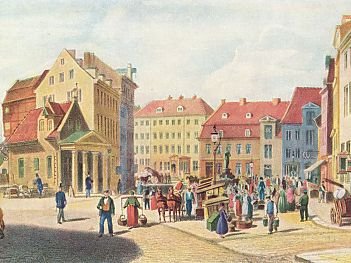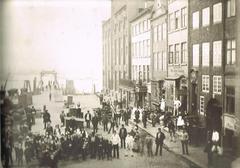
Altonaer Fischmarkt Visiting Hours, Tickets, and Hamburg Historical Sites Guide
Date: 15/06/2025
Introduction to Altonaer Fischmarkt
The Altonaer Fischmarkt in Hamburg is a living symbol of the city’s maritime traditions and vibrant urban culture. Established in 1703 along the Elbe River, it began as a humble marketplace for local fishermen to sell their catch before Sunday church services—an early morning ritual that endures today. Over the centuries, the market expanded its offerings beyond fish to include fresh produce, flowers, artisanal foods, and unique goods, reflecting Hamburg’s growth as a major port and cosmopolitan hub.
Today, the Altonaer Fischmarkt is more than a market: it is an institution where locals and visitors converge to experience theatrical Marktschreier (market criers), sample iconic Fischbrötchen (fish sandwiches), and enjoy live music in the historic Fischauktionshalle (Fish Auction Hall). With its accessible location, inclusive facilities, and proximity to other city highlights, the market epitomizes Hamburg’s blend of tradition and contemporary flair. (Altonaer Fischmarkt Hamburg: Visiting Hours, Tickets & Historical Insights, Visiting the Altonaer Fischmarkt: Hours, Tickets, and Hamburg’s Historic Fish Market, Altonaer Fischmarkt Visiting Hours, Tickets, and Guide to Hamburg’s Historic Riverside Market)
Historical Overview
Origins and Early Development (1703–19th Century)
Founded in 1703, the Fischmarkt originally offered a venue for fishermen to sell fresh catches before church services. The market’s dawn opening became a defining city tradition. As Hamburg grew, the market diversified—adding produce, flowers, and artisanal products—mirroring the city’s bustling trade and international influences.
Rivalry and Unification
For centuries, separate markets in Hamburg and neighboring Altona competed for dominance in the fish trade. This rivalry ended in 1938 with the Greater Hamburg Act, merging Altona into Hamburg and consolidating the markets into a single, prestigious institution.
Construction and Significance of the Fischauktionshalle
In 1896, the iconic Fischauktionshalle was built, designed in the style of a Roman basilica. Its steel-and-glass architecture enabled industrial-scale auctions, with multiple vessels unloading simultaneously. The hall remains a striking example of industrial heritage and serves today as a venue for live music and events.
World War II and Postwar Era
The Fischauktionshalle was severely damaged during WWII. Although partially restored postwar, the market struggled until a major renovation in the early 1980s revived both the hall and the weekly event. Preservation efforts have transformed the Fischmarkt into a thriving cultural and commercial magnet.
Visiting Information
Market Hours and Admission
- April–October: Sundays, 5:00 AM – 9:30 AM
- November–March: Sundays, 7:00 AM – 9:30 AM
- Fischauktionshalle: Sundays, 6:00 AM – 12:00 PM (live music; no brunch service)
Admission: Entry is free for both the outdoor market and the Fischauktionshalle. Some special events inside the hall may require separate tickets—check event listings for details. (rausgegangen.de)
Location and Getting There
- Address: Fischmarkt, 22767 Hamburg, Germany
- By Train: S-Bahn to Altona or Reeperbahn, U-Bahn to St. Pauli.
- By Bus: Multiple lines stop nearby.
- By Ferry: Elbe ferries offer scenic access.
- Parking: Limited; public transit is strongly recommended.
Accessibility
The market area and Fischauktionshalle are generally wheelchair accessible, with paved surfaces and ramps. However, cobblestones and crowds may present challenges. Public transport and nearby facilities are equipped for visitors with disabilities.
What to Expect: Market Experience
Atmosphere and Setting
The riverside setting along Große Elbstraße offers panoramic harbor views, the lively calls of market criers, and the aromas of fresh seafood and coffee. The market draws a unique blend of early risers, families, tourists, and partygoers from the Reeperbahn nightlife district.
Stalls and Offerings
- Seafood: Fresh fish (herring, salmon, North Sea crabs), smoked eel, shellfish, and the renowned Fischbrötchen.
- Produce: Seasonal fruits and vegetables, herbs, and flowers.
- Other Goods: German sausages, cheeses, pastries, household items, souvenirs, artisan crafts, and sometimes live animals (ducks, rabbits, birds).
- Street Food: Diverse snacks reflecting Hamburg’s multicultural influences.
Market Criers (Marktschreier)
Colorful market criers are a central spectacle, captivating crowds with their theatrical sales pitches, playful banter, and lively auctions. Their tradition is regarded as part of Hamburg’s intangible cultural heritage.
Live Music and Social Scene
Each Sunday, the Fischauktionshalle hosts live music—ranging from jazz and rock to traditional German tunes—creating a festive ambiance. The hall is a gathering point for all ages, blending morning tradition with nightlife energy.
Tips for Visitors
- Arrive Early: The market is liveliest and best-stocked in the first hours after opening.
- Bring Cash: Most stalls prefer cash; ATMs are nearby but can be busy.
- Dress Appropriately: Weather can change quickly; dress in layers and wear comfortable shoes.
- Photography: Capture the unique scenes, but always ask vendors before taking photos.
- Bargaining: Some negotiation is possible, especially towards closing.
- Family & Pets: The market is family-friendly; dogs are allowed on leashes, but it can be crowded and noisy for some pets.
- Accessibility: The area is generally accessible, but cobblestones and crowds may be challenging.
Nearby Attractions
- Elbphilharmonie: Hamburg’s world-famous concert hall.
- Reeperbahn: Legendary nightlife and entertainment district.
- Altona & Ottensen: Trendy neighborhoods with cafes, boutiques, and parks.
- Landungsbrücken: Historic harbor piers, ideal for boat tours.
Special Events and Seasonal Highlights
From April to October, the market is particularly vibrant. Seasonal festivals, live music events, and themed markets add extra flair. The Altona district’s “altonale” festival further enriches the cultural atmosphere.
Frequently Asked Questions (FAQ)
Is there an entry fee or tickets required?
No, entry to the market and the Fischauktionshalle is free.
What are the market’s opening hours?
Sundays: 5:00–9:30 AM (April–October), 7:00–9:30 AM (November–March).
How do I get to the Altonaer Fischmarkt?
Public transport is recommended: S-Bahn (Altona or Reeperbahn), U-Bahn (St. Pauli), bus, or ferry.
Are guided tours available?
Yes, guided tours are occasionally offered—check local listings or visitor centers for current information.
Is the market accessible for people with disabilities?
Generally yes, though cobblestones and crowds may pose challenges.
Are pets allowed?
Dogs are permitted on a leash.
Are there special events?
Seasonal festivals, live music, and themed markets occur throughout the year.
Enhance Your Visit
- Images: Use high-quality photos with alt tags such as “Altonaer Fischmarkt seafood stalls,” “Live music inside Fischauktionshalle,” and “Market criers at Altonaer Fischmarkt.”
- Map: Embed an interactive map showing the market location and public transport links.
- Related Articles: Link to articles on Hamburg’s historical sites, nightlife, and best seafood restaurants.
Plan Your Visit
For the latest information on visiting hours, special programming, and guided tours, consult official market websites and use the Audiala app for real-time updates and insider tips. The Altonaer Fischmarkt is a must-see for anyone seeking to experience Hamburg’s authentic maritime spirit, culinary delights, and lively community.
Sources
- Altonaer Fischmarkt Hamburg: Visiting Hours, Tickets & Historical Insights
- Visiting the Altonaer Fischmarkt: Hours, Tickets, and Hamburg’s Historic Fish Market
- Altonaer Fischmarkt Visiting Hours, Tickets, and Guide to Hamburg’s Historic Riverside Market
- Altonaer Fischmarkt Visiting Hours, Tickets, and Visitor Guide in Hamburg
- Event listing for Fischauktionshalle
- Travel blog: Altona, Hamburg’s Riverside Gem
- Germany Travel Blog: Hamburg Fish Market




















































































